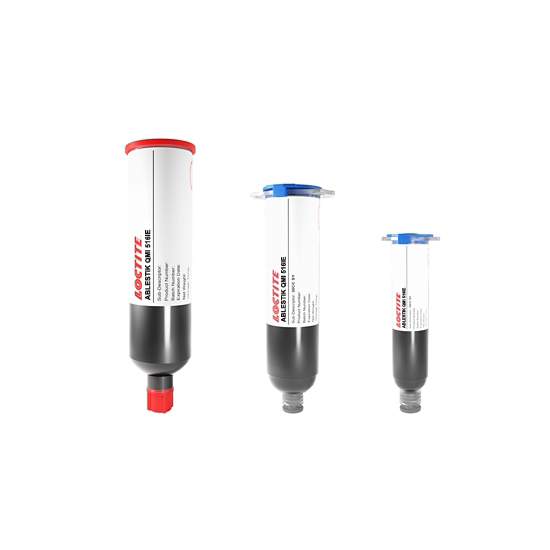LOCTITE ABLESTIK QMI 516IE
- Electrically conductive
- Hydrophobic
- Snap cure
Product Description
LOCTITE ABLESTIK QMI516IE electrically conductive adhesive is designed for die attach applications. It is a hydrophobic Bismaleimide (BMI) hybrid that is stable at high temperatures and creates a void free bondline.
LOCTITE ABLESTIK QMI516IE is a Snap curable adhesive, designed for high throughput bonding applications. It can cure fast in low temperatures. This adhesive, typically used for heat sensitive devices, cures in low temperatures and exhibits excellent adhesive strength to a variety of substrates.
Snap Cure
- 60 seconds @ 90°C
Oven Cure
- 90 minutes @ 60°C
Technical Specifications
| General Properties | |
| Pot Life Pot Life Pot life is the amount of time it takes for the viscosity of a material to double (or quadruple for lower viscosity materials) in room temperature after a material is mixed. It is closely related to work life but it is not application dependent, less precise and more of a general indication of how fast a system is going to cure. | 6 hours |
| Specific Gravity Specific Gravity Specific gravity (SG) is the ratio of the density of a substance to the density of a reference substance; equivalently, it is the ratio of the mass of a substance to the mass of a reference substance for the same given volume. For liquids, the reference substance is almost always water (1), while for gases, it is air (1.18) at room temperature. Specific gravity is unitless. | 3.7 |
| Thermal Properties | |
| Glass Transition Temperature (Tg) Glass Transition Temperature (Tg) The glass transition temperature for organic adhesives is a temperature region where the polymers change from glassy and brittle to soft and rubbery. Increasing the temperature further continues the softening process as the viscosity drops too. Temperatures between the glass transition temperature and below the decomposition point of the adhesive are the best region for bonding. The glass-transition temperature Tg of a material characterizes the range of temperatures over which this glass transition occurs. | 43 °C |
| Physical Properties | |
| Thixotropic index Thixotropic index Thixotropic Index is a ratio of a material s viscosity at two different speeds in Ambient temperature, generally different by a factor of ten. A thixotropic material s viscosity will decrease as agitation or pressure is increased. It indicates the capability of a material to hold its shape. Mayonnaise is a great example of this. It holds its shape very well, but when a shear stress is applied, the material easily spreads. It helps in choosing a material in accordance to the application, dispense method and viscosity of a material. | 5.6 |
| Viscosity Viscosity Viscosity is a measurement of a fluid’s resistance to flow. Viscosity is commonly measured in centiPoise (cP). One cP is defined as the viscosity of water and all other viscosities are derived from this base. MPa is another common unit with a 1:1 conversion to cP. A product like honey would have a much higher viscosity -around 10,000 cPs- compared to water. As a result, honey would flow much slower out of a tipped glass than water would. The viscosity of a material can be decreased with an increase in temperature in order to better suit an application | 15,900 mPa.s |
Additional Information
What is going on with Bismaleimide based materials and bleeding?
Bleeding is a known “side effect” of QMI products based on BisMaleImide (BMI) resin. The relatively low BMI resin viscosity allows higher filler loading and this makes this resin popular for semiconductor die attach use (next to its higher temperature and moisture resistance vs epoxies for instance). By using very fast “snap cure” profiles like most semiconductor companies do, bleeding can be controlled. Acrylate resin based products like CA 3556HF show less bleeding in general.
Bleeding can be also controlled by surface treatments, curing process and adding anti-bleed agents to the adhesives.
Sometimes if you take the relatively short pot life at 25C and high reactivity of QMI resins into account, next to its higher bleeding and higher resin cost base, we could suggest to focus on CA 3556HF and lower silver content ICP 8282 for specific applications. It is all application dependent and we are happy to help you choose.



